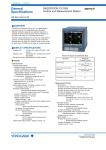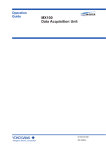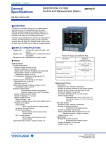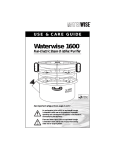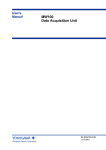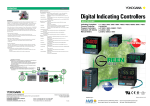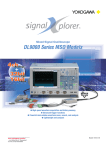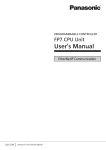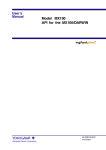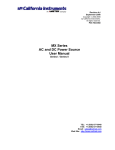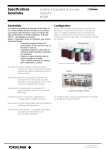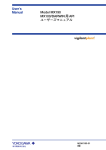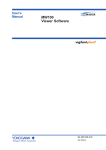Download General specifications
Transcript
PC-Based Data Acquisition Unit A PC-based data acquisition system for the future, delivering unparalleled performance. When combined with Yokogawa's proprietary PC software, the MX100's high speed, multi channel capability, and high withstand voltage offers the ultimate in measurement power. www.yokogawa.com/tm/ ... and subscribe to “Newswave,” our free e-mail newsletter Bulletin 04M08B01-00E MX100 is a data acquisition unit designed to operate as a front end for PCs. Data measured by MX100 is transferred to PCs in real-time. Connection between a single MX unit and a single PC (measurement of 24 channels/10 ms or 60 channels/100 ms) One MX unit enables data acquisition on up to 24 channels at a measurement interval of 10 ms or up to 60 channels at a measurement interval of 100 ms (six modules installed in both cases). Measured data <Setting up the System> The MX and PC are connected via a hub and a straight Ethernet cable. Alternatively, they can be connected using a cross cable alone, without using the hub. HUB Straight cable 100Base-TX <PC Software> Input signal: DC voltage Thermocouple RTD Digital input (Mixed input possible) In a one-to-one connection, the MX100 standard software included with the main module facilitates easy building of data acquisition environments. Output signal: Digital output One MX unit consists of a combination of a main module, input/output modules, and a base plate. This configuration centers on the main module. For details, refer to pages 4 and 5. Connection between multiple MX units and a single PC (for measurement of up to 1,200 channels and the use of MXLOGGER) Example of a system with multiple MX units: HUB Straight cable 100Base-TX <Setting up the System> The MX units and the PC are connected by means of a hub and straight Ethernet cables. <PC Software> Acquisition of data from multiple MX units is wellsupported by Yokogawa’s software “MXLOGGER” (optional). MXLOGGER enables data acquisitions of up to 20 MX units (one unit has inputs of up to 60 channels, or 1,200 channels on 20 units). Maximum Performance..... ■ High-Speed, Multi-Channel Capability, High withstand Voltage • Shortest measurement interval of 10 ms (high-speed measurement of 10 ms on 24 channels or 100 ms on 60 channels is possible). • Possible to acquire data from up to 1,200 channels (when using Yokogawa's proprietary software). • Reinforced insulation between the input terminal and the case handles 3700 Vrms for one minute, or 600 Vrms/VDC continuous. ■ Multi-Interval Measurement • Mixed use of three types of measurement intervals is enabled within the system (measurement intervals are set for each module). Please note that the shortest measurement interval of MXLOGGER depends on the system's total number of channels and the PC's performance. For guidelines on measurement intervals and the number of channels, please refer to page 6. • • • If users wish to create their own data acquisition software, there is no limit to the number of MX units that can be integrated with a single PC software element. Please note, however, that if conditions with heavy loads (such as short measurement intervals with many units) are set to the PC and its software, data will not be acquired in time and some data may be lost. Ease of Use..... ■ Flexible System Configuration By configuring modules, a system can be built or modified to utilize 4 to 1,200 channels, and measurement intervals of 10 ms to 60 s. ■ Versatile PC-Based Software Options Software developed by Yokogawa, an API, and a LabVIEW driver are available. ■ Easy Software Setup PC software developed by Yokogawa automatically identifies any connected MX100s. Up to 20 units ■ No Re-Wiring between Measurements A removable terminal unit is available. 2 3 MX100 is a data acquisition unit designed to operate as a front end for PCs. Data measured by MX100 is transferred to PCs in real-time. Connection between a single MX unit and a single PC (measurement of 24 channels/10 ms or 60 channels/100 ms) One MX unit enables data acquisition on up to 24 channels at a measurement interval of 10 ms or up to 60 channels at a measurement interval of 100 ms (six modules installed in both cases). Measured data <Setting up the System> The MX and PC are connected via a hub and a straight Ethernet cable. Alternatively, they can be connected using a cross cable alone, without using the hub. HUB Straight cable 100Base-TX <PC Software> Input signal: DC voltage Thermocouple RTD Digital input (Mixed input possible) In a one-to-one connection, the MX100 standard software included with the main module facilitates easy building of data acquisition environments. Output signal: Digital output One MX unit consists of a combination of a main module, input/output modules, and a base plate. This configuration centers on the main module. For details, refer to pages 4 and 5. Connection between multiple MX units and a single PC (for measurement of up to 1,200 channels and the use of MXLOGGER) Example of a system with multiple MX units: HUB Straight cable 100Base-TX <Setting up the System> The MX units and the PC are connected by means of a hub and straight Ethernet cables. <PC Software> Acquisition of data from multiple MX units is wellsupported by Yokogawa’s software “MXLOGGER” (optional). MXLOGGER enables data acquisitions of up to 20 MX units (one unit has inputs of up to 60 channels, or 1,200 channels on 20 units). Maximum Performance..... ■ High-Speed, Multi-Channel Capability, High withstand Voltage • Shortest measurement interval of 10 ms (high-speed measurement of 10 ms on 24 channels or 100 ms on 60 channels is possible). • Possible to acquire data from up to 1,200 channels (when using Yokogawa's proprietary software). • Reinforced insulation between the input terminal and the case handles 3700 Vrms for one minute, or 600 Vrms/VDC continuous. ■ Multi-Interval Measurement • Mixed use of three types of measurement intervals is enabled within the system (measurement intervals are set for each module). Please note that the shortest measurement interval of MXLOGGER depends on the system's total number of channels and the PC's performance. For guidelines on measurement intervals and the number of channels, please refer to page 6. • • • If users wish to create their own data acquisition software, there is no limit to the number of MX units that can be integrated with a single PC software element. Please note, however, that if conditions with heavy loads (such as short measurement intervals with many units) are set to the PC and its software, data will not be acquired in time and some data may be lost. Ease of Use..... ■ Flexible System Configuration By configuring modules, a system can be built or modified to utilize 4 to 1,200 channels, and measurement intervals of 10 ms to 60 s. ■ Versatile PC-Based Software Options Software developed by Yokogawa, an API, and a LabVIEW driver are available. ■ Easy Software Setup PC software developed by Yokogawa automatically identifies any connected MX100s. Up to 20 units ■ No Re-Wiring between Measurements A removable terminal unit is available. 2 3 The MX is designed to enable desired measurement environments by combining three elements: the main module, input/output modules, and a base plate. The assembled unit can be utilized on the desktop as-is (the modules have legs). Please note that DIN rails are used for rack-mounting. Base Plate Input/Output Module Main Module Main Module (MX100) The main module is the engine that controls data acquisition. It is equipped with a power supply, an Ethernet port, and a CompactFlash card slot. One main module can accommodate up to six input/output modules. The user can choose up to six moduels of any type. Ethernet Port: For communication with the PC. Automatic recognition of 100Base-TX or 10Base-T Data Backup Time by CF Card Size (Note: Minutes/hours/days are approximate.) Number of saved channels 10 channels CF (CompactFlash) Card Slot: With the CF Card, measured data is saved to the card if communication with the PC is interrupted. Since the card provides data backup, you do not have to worry about the possible loss of data even if the MX is configured for PC-based measurement. 24 channels 60 channels Measurement interval 32 M 128 M 512 M 10 ms 100 ms 500 ms 2s 10 ms 100 ms 500 ms 2s 10 ms 100 ms 500 ms 2s 2 hours 21 hours 4.5 days 18 days 54 minutes 9 hours 45 hours 7.5 days 18 minutes 3.5 hours 18 hours 3 days 9 hours 3.5 days 18.5 days 75.5 days 3.5 hours 37 hours 7.5 days 31.5 days 75 minutes 15 hours 3 days 12.5 days 36 hours 15 days 75.5 days 303 days 15 hours 6 days 31.5 days 126 days 5 hours 2.5 days 12.5 days 50 days Input/Output Modules (MX110, MX115, MX125) ■ Four-Channel High-Speed Universal Input Module MX110-UNV-H04 Note: All I/O modules are fitted with a swing-up terminal cover. MX110-UNV-M10 Shortest measurement interval: 10 ms; Maximum number of input channels: 4 channels; Mixed input of DC voltage, thermocouple, RTD, and digital input: possible. Please note that the shortest measurement interval for temperature is 50 ms for this module. Shortest measurement interval: 100 ms; Maximum number of input channels: 10 channels; Mixed input of DC voltage, thermocouple, RTD, and digital input: possible ■ Ten-Channel High-Speed Digital Input Module ■ Ten-Channel Medium-Speed Digital Output Module MX115-D05-H10 If a single unit consists of this module only, measurement of 60 channels/10 ms is possible. Most suitable for measurement of digital input signals at many points inexpensively. Shortest measurement interval: 10 ms; Maximum number of input channels: 10 channels; Digital input dedicated module. 4 ■ Ten-Channel Medium-Speed Universal Input Module MX125-MKC-M10 For use of alarm outputs, etc. Shortest output interval: 100 ms; Maximum number of output channels: 10 channels; Digital output dedicated module. Base Plate (MX150) The main module and input/output modules are connected by means of connectors on a base plate. For one input/output module through Although the position for the main module is fixed, input/output modules can be configured in any position using the module connectors. One to six modules can be used. ○ ○ ○ six input/output modules <Using the Base Plate for Six Input/Output Modules> Connector covers (772066) are available for vacant slots. Modules and Terminals <Attachable/Detachable Terminals> All input terminals can be attached/detached. If the user provides multiple terminals, there is no need to perform rewiring every time measurement is carried out. ■ Four-Channel High-Speed ■ Ten-Channel Medium-Speed Universal ■ Ten-Channel Medium-Speed Universal Input Module Input Module Digital Output Module MX110-UNV-H04 MX110-UNV-M10 MX125-MKC-M10 ■ Ten-Channel High-Speed Digital Input Module MX115-D05-H10 Plate with clamp terminals (with RJC)(772063) MX115-D05-H10’s plate with clamp terminals does not have RJC. RJC: Reference Junction Compensation Clamp terminal (772064) Each terminal can be attached/detached. Clamp terminal (772065) Each plate with terminals can be attached/detached. Each terminal can be attached/detached. <Screw Terminal Block> A separate screw terminal block is available for the MX110-UNV-M10 Ten-Channel Medium-Speed Universal Input Module and the MX115-D05-H10 Ten-Channel High-Speed Digital Input Module. Connection Cable (772062) between input modules and the screw terminal block Detach the plate with clamp terminals from the MX110-UNVM10 or MX115-D05-H10. Then, use the connection cable (772062) to connect the input module without the plate to the screw terminal block (772061). Screw Terminal Block (772061) The screw terminal block is installed. The option code /NC can be added to the MX110-UNV-M10 and MX115-D05-H10 to indicate whether or not the plate with clamp terminals is included at the time of delivery. If the user requires only the screw terminal block and not the clamp terminals, please specify either MX110-UNV-M10/NC or MX115-D05-H10/NC. <Mounting of Racks or Panels Using the DIN Rail> Use the DIN rail for mounting on racks or panels. The DIN rail can be easily attached using the dedicated bracket. Two brackets come standard with the base plate (MX150). Bracket for mounting the DIN rail 5 High-Speed, Multi-Channel Capability The table below provides reference information on the maximum number of measurable channels in relevant measurement intervals (when using Yokogawa's proprietary software): PC Software Measurement interval Maximum number of measurable channels 10 ms 24 channels 50 ms 24 channels 50 ms 120 channels 100 ms Number of Necessary Modules (example) MX100 Standard Software MXLOGGER Main Module (MX100) DCV/DI √ √ 1 6 - DCV/TC/RTD/DI √ √ 1 6 - DCV/TC/RTD/DI - √ 5 30 - 60 channels DCV/TC/RTD/DI √ √ 1 0 6 100 ms 300 channels DCV/TC/RTD/DI - √ 5 0 30 200 ms 500 channels DCV/TC/RTD/DI - √ 9 0 50 500 ms 600 channels DCV/TC/RTD/DI - √ 10 0 60 1000 ms 1200 channels DCV/TC/RTD/DI - √ 20 0 120 Measurable objects Four-Channel High-Speed Ten-Channel Medium-Speed Universal Input Module Universal Input Module (MX110-UNV-H04) (MX110-UNV-M10) √ measurement that support is possible - measurement that support is not possible. The relationship between measurement intervals and the number of channels largely depends on the performance of the PC. The actual performance may differ from that shown in the table. <PC System Requirements> CPU: Pentium 4 3.2 GHz; Memory: 1 GB; OS: Windows 2000; Hard disk: 160 GB; Communication interface: Ethernet 100Base-TX Multi-Interval Measurement Three types of measurement intervals can be used in a single system in various combinations. Measurement intervals are specified for each module. It is also possible to set different types of input modules to the same measurement interval or to set the same type of input modules to different measurement intervals. Twelve measurement intervals are available as userselectable options: 10 ms, 50 ms, 100 ms, 200 ms, 500 ms, 1 s, 2 s, 5 s, 10 s, 20 s, 30 s and 60 s. Please note, however, that measurement intervals of 10/50 ms cannot be set to the Medium-speed Universal Input Module (MX110-UNV-M10). <Examples of Setting Measurement Intervals> <Monitor Window Using Yokogawa's Proprietary PC Software> Multi-interval systems can be flexibly built for each module as shown in the figure below. Three colors are used to indicate the three types of measurement intervals. The window shows measurement values by measurement intervals. Measurement can be performed while confirming rapidly-changing signals and slowly-changing signals simultaneously. Example 1 Example 2 Example 3 Measurement of sine waves at 8 Hz with a measurement interval of 10 ms Measurement of sine waves at 0.5 Hz with a measurement interval of 100 ms 6 Measurement of sine waves at 1 Hz with a measurement interval of 50 ms High Withstand Voltage (Reinforced Insulation) Reinforced (double) insulation has been provided between the input terminals and the case to achieve a high withstand voltage of 600 Vrms/VDC (continuous). As shown below, each battery voltage can be measured even if the batteries are stacked to increase common-mode voltages. Allowable common-mode voltage of one MX system: Vmax = 600 Vrms/Vdc (continuous) MX system Measurement object CHn CH (n–1) • * • Module (N) • CH1 Allowable common-mode voltage between modules Vmax = 600 Vrms/Vdc (continuous) CHn • * • Module 1 • CH2 CH1 N: 4 or 10 * Allowable common-mode voltage between channels in a module • Ten-Channel Universal Input Module: 120 Vrms/Vdc (continuous) • Four-Channel Universal Input Module: 250 Vrms/Vdc (continuous) Noise Rejection (MX110-UNV-H04) MX input modules employ integrating A/D converters with superior noise rejection performance. In particular, the MX110-UNVH04 Four-Channel High-Speed Universal Input Module incorporates an integrating A/D converter for each input channel, thereby exhibiting strong noise rejection performance in high-speed measurement. Moreover, the digital filtering function is effective on noises that cannot be fully rejected even with integrating A/D converters. Time constants can be selected from 5 to 100 measurement interval times. Therefore, filtering can be applied according to the noise to be rejected. <Example of Noise Rejection> When the noise source in the left figure was applied to the MX, the result in the right figure was obtained. High-speed measurement can be stably performed even in noise environments. • Output window of MX100 for noise inputs Module used: MX110-UNV-H04 Four-Channel High-Speed Universal Input Module Measurement with the range of 2 V (-2 V to +2 V), measurement interval of 50 ms, integral time “Auto” and filter “OFF.” • Noise source applied to MX The noise signal was applied between H and L (in normal mode). 1V 1V 200 ms –1 V –1 V 10 µs Sampling rate: 500 MS/s Measurement using Yokogawa’s Digital Oscilloscope DL1740. The MX Standard Software was used for PC software. 7 MX100 Standard Software (Standard Software for the Main Module MX100) This software is used to connect a single MX unit for performing data acquisition (it is not possible to connect multiple MX units). It includes three software elements: integration monitor, viewer, and calibration. <Integration Monitor Software> This software performs real-time monitoring and logging of measured data. It consists of six menus: Monitor Window, Detailed Display Setting, Channel Setting, Acquisition Condition, System Setting, and Connection/disconnection. • Monitor Window • Acquisition Condition This window is used to monitor measured data in real-time. It enables waveform displays and digital displays. This menu is used to set various conditions (such as measurement intervals/data save intervals, measurement start/ end conditions, or file name designation) for data acquisitions. Drag and drop the symbol of the input module. Then, allocate it to the measurement interval group. Digital output signals can be generated manually from these buttons. Integration Monitor Software provides menu bars in all windows. The user can make transitions to other menu windows from any menu window. • Detailed Display Setting • System Setting This menu is used to set data display states (such as waveform colors) in the monitor window. This menu is used to decide module configurations, etc. Module configurations are shown in easily understood diagrams. • Channel Setting • Connection/Disconnection (Easy to Set Up) This menu is used to enter individual settings (such as range settings) for each input channel or to set computation channels (such as the input of computing equations). The connected MX100 is identified automatically. Once connection setting information is provided, it will be retained. When the system restarts, the MX100 will be connected automatically without making network settings. The connected MX100 is identified automatically. MX being used by other users can be confirmed here. Select the MX to be connected. If necessary, provide network settings such as IP addresses. All of the network settings/changes can be performed from the PC software: there is no need to access the MX100 itself directly (for example, hardware switch settings). 8 <Viewer Software> <Calibration Software> This software is intended to re-display saved data. It enables waveform displays, digital displays, cursor displays, interval arithmetic, and other functions. This software is intended to efficiently carry out the calibration of universal input modules. Measured data can be converted into various formats such as Excel, Lotus, or ASCII. Data saved in multiple measurement intervals are re-displayed in each measurement interval (using one data file). Results of interval arithmetic MXLOGGER (Optional PC Software) MXLOGGER is used to connect multiple MX units (up to 20 units) for data acquisition (one MX unit can also be connected). It consists of software elements (setting, logger (for saving data), monitor, and viewer) and the monitor server. The monitor server function is used to enable connections with Yokogawa’s data logging software, “DAQLOGGER.” It is effective when combining MX units with Yokogawa’s data acquisition equipment such as DARWIN and DAQSTATION. (DAQLOGGER is scheduled to be capable of supporting MXLOGGER’s monitor server function in July 2003.) Example of building a mixed system of MX100 and DARWIN: DAQLOGGER becomes a client of MXLOGGER to simultaneously retrieve data from MXLOGGER and from DARWIN. DA100/DC100 Note: The shortest data acquisition interval of DAQLOGGER is one second. If it is necessary to save data with a measurement interval of less than one second, data needs to be saved by MXLOGGER. DR130/230/240 MV100/200 DAQLOGGER and MXLOGGER are provided as basic software for Yokogawa’s data acquisition PC software “DAQWORX.” DX100/200 API for MX100/DARWIN (Optional) If users wish to create their own data acquisition software, please use this API. The API consists of a suite of functions to communicate with MX100/DARWIN. The suite of functions contains DLL (dynamic link library). API makes it possible to create data acquisition software dedicated to the MX, or data acquisition software combining the MX and DARWIN, or data acquisition software dedicated to DARWIN. Three languages (Visual C, Visual C++, and Visual Basic) are supported. 9 Hardware Specifications * Measurement Ranges and Accuracies Common Specifications Type Input • Normal operating conditions: * * * * * * 0-50˚C 20-80% RH for 0-40˚C 10-50% RH for 40-50˚C Rated power supply voltage: AC power supply, 100-240 VAC Range of operating power supply voltage: AC power supply, 90-250 VAC Power supply frequency: 50 Hz ± 2%, 60 Hz ± 2% Power consumption: Up to approximately 70 VA when six modules are used Installation method: Desktop/floor and panel mount (using the DIN rail) Supported standards: CSA Obtained CSA22.2 No.1010.1, 20 mV 60 mV 200 mV 2V 6V 20 V 100 V R S * Operating temperature range: * Operating humidity range: UL CE C-Tick Voltage Installation category (Overvoltage category): II, Degree of pollution: 2 Obtained UL61010B-1 (CSA NRTL/C) EMC directive EN61326 EN61000-3-2 EN61000-3-3 EN55011 Class A Group 1 Low voltage EN61010-1 directive Measurement category: II, Degree of pollution: 2 AS/NZS 2064 Class A Group 1 Thermocouple RJC accuracy not included. Burn-out setting is "OFF." Model-Specific Specifications • Main Module (MX100) * Main functions: Control of the power supply and input/output modules, communication with the PC, storage of data on the CF card (during a communication failure) * Number of maximum connectable input/output modules: 6 (arbitrary for six modules or less) * Measurement interval: Up to three types can be set per system (multi-interval) Types of measurement intervals are 10/50/100/200/500 ms, 1/2/ 5/10/20/30/60 sec. Note that configurable measurement intervals differ depending on modules. * Transfer interval of measured data to the PC: Minimum 100 ms * DO interval (update interval): 100 ms (not synchronized with timing every measurement interval of 100 ms) * Filter function: First-order lag filter. The function can be set for each channel. Time constant = measurement interval × N (where N is any number of the following: 5, 10, 20, 25, 40, 50, and 100). * Input computation function (computation function that can be executed in the main module) Computation of differences between channels: differential computation between arbitrary channels (DCV, TC, RTD, DI, scaling) Linear scaling computation Possible range for scaling: DCV, TC, RTD, DI Possible scope for scaling: –30,000 to 30,000 Position of the decimal point: any digit * Alarm (alarm function can be executed in the main module. This function is enabled even during a communication failure). Alarm types: Upper limit, lower limit, differential upper limit, and differential lower limit Number of settings: two items per channel Possible range for alarm setting: DCV, TC, RTD, DI, scaling Hysteresis: Alarm “ON/OFF” values are set arbitrarily. Number of alarm output points: 10-60 points according to the number of mounted “DO” modules Output mode: Excitation/non-excitation, OR, Hold/non-Hold, command output * Saving the data Save function: Backup in the event of a communication failure during data acquisitions by the PC. Supported external media: CF Card (up to 2 Gbytes) Type, I, II × one slot Save trigger: When the timeout value (60 s) is exceeded if communication is interrupted during the PC’s data acquisitions. Save channel: Monitor “ON” channel Save interval: Data is saved automatically (approximately every 60 s) Stopping the save function: If the PC’s data acquisition is recovered or if the CF Switch is pressed. Data guarantee during a power failure: Guaranteed until data is written immediately before the MX is turned off (for example, power failure). The backup operation will not continue after the system recovers from a power failure. * Indication LED: Indication of Ethernet status. 7-segment indication: MX status indication by 7 segments in 2 digits (unit no., operation status indication, indication of error occurrence, indication of messages concerning the CF Card, etc.) * Communication functions Interface: 100Base-TX/10Base-T (automatic detection) Ethernet Basic protocol: TCP, IP, UDP, ARP, ICMP Transmission function: Transmission of measured values and setting values Receiving function: Reception of setting values * General specifications Power consumption: Approximately 8W for the main module only Insulation resistance: 20 MΩ or more (500 VDC) between the power supply terminal and the ground terminal Withstand voltage: 1500 VAC (50/60 Hz) between the power supply terminal and the ground terminal, one minute External dimension: Approximately 92 × 131 × 137 mm Weight: Approximately 0.85 kg * Other functions Switch: 8-bit dip switch (for IP address initialization, etc.) CF switch: Switch to stop the data writing operations. RTD measurement current (1 mA) RTD measurement current (2 mA) DI * Types of measurement: 10 Number of measurement points: Input method: A/D resolution: Measurement interval: A/D integral time: DC voltage, thermocouple, RTD, DI (non-voltage contact, level (5 V logic)) 4 (A/D to be equipped independently for each channel) Floating unbalanced input, insulation between channels ±20000/±6000 (16-bit A/D is used) 10/50/100/200/500 ms, 1/2/5/10/20/30/60 s 1.67/16.67/20/36.67/100/200 ms, AUTO A/D integral time is determined by measurement intervals ±(0.05% of rdg.⫹5 digits) ±(0.05% of rdg.⫹2 digits) ±(0.05% of rdg.⫹5 digits) ±(0.05% of rdg.⫹2 digits) ±(0.05% of rdg. ⫹1˚C) However, R, S: 0 to 100˚C: ±3.7˚C 100 to 300˚C: ±1.5˚C B: 400 to 600˚C: ±2˚C B 0.0 to 1820.0˚C Less than 400˚C: accuracy is not guaranteed ±(0.05% of rdg. ⫹0.7˚C) K –200.0 to 1370.0˚C However, –200 to –100˚C: ±(0.05% of rdg. +1˚C) Measurement not possible E –200.0 to 800.0˚C ±(0.05% of rdg. ⫹0.5˚C) J –200.0 to 1100.0˚C However, J, L: T –200.0 to 400.0˚C –200 to –100˚C: ±(0.05% of rdg. ⫹0.7˚C) L –200.0 to 900.0˚C U –200.0 to 400.0˚C ±(0.05% of rdg.⫹0.7˚C) N 0.0 to 1300.0˚C ±(0.05% of rdg.⫹1˚C) W 0.0 to 2315.0˚C ±(0.05% of rdg.⫹0.7K) KpvsAu7Fe 0.0 to 300.0K Pt100 –200.0 to 600.0˚C ±(0.05% of rdg. ⫹0.3˚C) Measurement not possible JPt100 –200.0 to 550.0˚C Pt100: high resolution –140.00 to 150.00˚C ±(0.05% of rdg. ⫹0.3˚C) Measurement not possible JPt100: high resolution –140.00 to 150.00˚C Ni100SAMA –200.0 to 250.0˚C ±(0.05% of rdg. ⫹0.3˚C) Measurement not possible Ni100 DIN –60.0 to 180.0˚C Ni120 –70.0 to 200.0˚C Pt100 –200.0 to 250.0˚C ±(0.05% of rdg. ⫹0.3˚C) Measurement not possible JPt100 –200.0 to 250.0˚C Pt100: high resolution –140.00 to 150.00˚C ±(0.05% of rdg. ⫹0.3˚C) Measurement not possible JPt100: high resolution –140.00 to 150.00˚C Pt50 –200.0 to 550.0˚C ±(0.05% of rdg. ⫹0.3˚C) Cu10 GE –200.0 to 300.0˚C Cu10 L&N –200.0 to 300.0˚C Measurement not possible ±(0.1% of rdg. ⫹0.7˚C) Cu10 WEED –200.0 to 300.0˚C Cu10 BAILEY –200.0 to 300.0˚C ±(0.05% of rdg. ⫹0.3K) Measurement not possible J263B 0.0 to 300.0 K Level Vth = 2.4 V Threshold level accuracy ±0.1 V Contact 100 Ω or less: ON, 10 kΩ or more: OFF 0.0 to 1760.0˚C Input Type Rated measurement range Measurement accuracy integral time 16.67 ms or more Measurement accuracy integral time 1.67 ms Voltage 60 mV 1V 6V 0 to ⫹60 mV –1 V to ⫹1 V 0 to ⫹6 V ±(0.05% of rdg.⫹20 digits) ±(0.05% of rdg.⫹2 digits) ±(0.05% of rdg.⫹20 digits) ±(0.1% of rdg.⫹100 digits) ±(0.1% of rdg.⫹10 digits) ±(0.1% of rdg.⫹100 digits) Supported thermocouple: Supported RTD: * * * * * * * * * * * * * • Four-Channel High-Speed Universal Input Module (MX110-UNV-H04) * * * * * –20 mV to ⫹20 mV –60 mV to ⫹60 mV –200 mV to ⫹200 mV –2 V to ⫹2 V –6 V to ⫹6 V –20 V to ⫹20 V –100 V to ⫹100 V Maximum resolution (1 digit) ±(0.1% of rdg.⫹25 digits) 1 µV 10 µV 10 µV ±(0.1% of rdg.⫹10 digits) 100 µV 1 mV 1 mV 10 mV Measurement accuracy integral time 1.67 ms 0.1˚C 0.1K 0.1˚C 0.01˚C 0.1˚C 0.1˚C 0.01˚C 0.1˚C 0.1K * Special Input Ranges (that can be used in MXLOGGER) • Base Plate (MX150) * Number of main modules that can be equipped: 1 (always equipped) * Number of I/O modules that can be equipped: 1-6 (to be specified according to the suffix codes) Rated Measurement accuracy measurement range integral time 16.67 ms or more * * * * * * * Maximum resolution (1 digit) 1 µV 100 µV 100 µV PLATINEL, PR40-20, NiNiMo, WRe3-25, W/WRe26, N (AWG14) PT100 (high noise resistance), JPt (high noise resistance), Cu10 (at 20˚C, a = 0.00392), Cu10 (at 20˚C, a = 0.00393), Cu25 (at 0˚C, a = 0.00425), Cu53 (at 0˚C, a = 0.00426035), Cu100 (at 0˚C, a = 0.00425), Pt25, Cu10 GE (high resolution), Cu10 L&N (high resolution), Cu10 WEED (high resolution), Cu10 BAILEY (high resolution) Reference junction compensation: External/internal switchover can be performed for each channel. Reference junction compensation accuracy: During the measurement of 0˚C or more and during the input terminal temperature balance Type R, S, W: ±1˚C Type K, J, E, T, N, L, U: ±0.5˚C (Note) Internal reference junction compensation of Type B is fixed to 0˚C. Maximum input voltage: 200 mV DC range or less, thermocouple, RTD, DI (non-voltage contact): ±10 VDC (continuous) Other measurement ranges: ±120 VDC (continuous) Normal-mode voltage: DCV, TC, DI (level): 1.2 times of rated range or less (50/60 Hz, peak values including signals) RTD 100 Ω system: 50 mV peak RTD 10, 25, 50 Ω systems: 10 mV peak Normal-mode rejection ratio (NMRR): When the integral time is 16.67 ms or more: 40 dB or more (50/60 Hz ±0.1%) When the integral time is 1.67 ms: 50/60 Hz is not rejected. Common-mode voltage: 600 VACrms (50/60 Hz), reinforced (double) insulation Common-mode rejection ratio (CMRR): 120 dB or more when the integral time is 16.67 ms or more. 80 dB or more when the integral time is 1.67 ms (50/60 Hz ±0.1%, 500 Ω imbalance, between the minus measurement terminal and the ground). Common mode voltage between channels: 250 VACrms (50/60 Hz), double insulation Noise rejection: Rejection by the integrating A/D converter and the use of low pass filters Input resistance: 10 MΩ or more for the DC voltage of 200 mV range or less and also for the thermocouple range. Approximately 1 MΩ if the DC voltage is 2 V range or more. Approximately 1 MΩ while measurement is stopped. Insulation resistance: 20 MΩ or more between the input and the ground (500 VDC) Input bias current: 10 nA or less (except for the burn-out setting) Withstand voltage: 2300 VAC (50/60 Hz) between input terminals, one minute 3700 VAC (50/60 Hz) between an input terminal and the ground, one minute Input signal source resistance: 2 kΩ or less for DC voltage and thermocouple 10 Ω or less per cable for RTD 50 Ω or 100 Ω systems 1 Ω or less per cable for RTD 10 Ω or 25 Ω systems Thermocouple burn-out: Superposed electric current system, detection within the thermocouple range (“ON/OFF” possible) Parallel capacity during RTD: 0.01 µF or less Power consumption: Approximately 3 W External dimension: Approximately 57 × 131 × 150 mm (including the terminal cover) Weight: Approximately 0.5 kg Terminal type: Clamp terminal. Applicable cable size is 0.2-2.5 mm2 (AWG2412) Approximately 57 × 131 × 150 mm (including the terminal cover) Approximately 0.5 kg Clamp terminal. Applicable cable size: 0.14-1.5 mm2 (AWG26-16) * Types of measurement: * External dimension: * Weight: * Terminal type: * * • Ten-Channel High-Speed Digital Input Module (MX115-D05-H10) • Ten-Channel Medium-Speed Universal Input Module (MX110-UNV-M10) * * * * DC voltage, thermocouple, RTD (non-voltage contact, level (5 V logic)) Number of measurement points: 10 (scanning of 10 channels with one A/D) Input method: Floating unbalanced input, insulation between channels (Note that RTD is common among “b” terminals.) A/D resolution: ±20000/±6000 (16-bit A/D is used) Measurement interval: 100/200/500 ms, 1/2/5/10/20/30/60 s A/D integral time: 1.67/16.67/20/36.67/100/200 ms, AUTO, A/D integral time is determined by measurement intervals. Measurement Ranges and Accuracies Input Type 20 mV 60 mV 200 mV 2V 6V 20 V 100 V R S Voltage Rated Measurement accuracy measurement range integral time 16.67 ms or more –20 mV to ⫹20 mV –60 mV to ⫹60 mV –200 mV to ⫹200 mV –2 V to ⫹2 V –6 V to ⫹6 V –20 V to ⫹20 V –100 V to ⫹100 V ±(0.05% of rdg.⫹5 digits) ±(0.05% of rdg.⫹2 digits) ±(0.05% of rdg.⫹5 digits) ±(0.05% of rdg.⫹2 digits) ±(0.05% of rdg. ⫹1˚C) However, R, S: 0 to 100˚C: ±3.7˚C 100 to 300˚C: ±1.5˚C B: 400 to 600˚C: ±2˚C 0.0 to 1820.0˚C B Less than 400˚C: accuracy is not guaranteed ±(0.05% of rdg. ⫹0.7˚C) –200.0 to 1370.0˚C However, –200 to –100˚C: K Thermocouple ±(0.05% of rdg. ⫹1˚C) RJC accuracy –200.0 to 800.0˚C E ±(0.05% of rdg. ⫹0.5˚C) not included. –200.0 to 1100.0˚C J However, J, L: –200.0 to 400.0˚C T –200 to –100˚C: –200.0 to 900.0˚C L ±(0.05% of rdg. ⫹0.7˚C) –200.0 to 400.0˚C U 0.0 to 1300.0˚C N ±(0.05% of rdg.⫹0.7˚C) 0.0 to 2315.0˚C W ±(0.05% of rdg.⫹1˚C) 0.0 to 300.0K KpvsAu7Fe ±(0.05% of rdg.⫹0.7K) –200.0 to 600.0˚C Pt100 ±(0.05% of rdg. ⫹0.3˚C) –200.0 to 550.0˚C JPt100 Pt100: high resolution –140.00 to 150.00˚C ±(0.05% of rdg. ⫹0.3˚C) JPt100: high resolution –140.00 to 150.00˚C RTD Ni100SAMA –200.0 to 250.0˚C measurement Ni100 DIN –60.0 to 180.0˚C current (1 mA) ±(0.05% of rdg. ⫹0.3˚C) Ni120 –70.0 to 200.0˚C DI Pt50 Cu10 GE Cu10 L&N Cu10 WEED Cu10 BAILEY J263B Level Contact 0.0 to 1760.0˚C Maximum resolution (1 digit) ±(0.1% of rdg.⫹25 digits) 1 µV 10 µV 10 µV ±(0.1% of rdg.⫹10 digits) 100 µV 1 mV 1 mV 10 mV ±(0.1% of rdg. ⫹4˚C) However, R, S: 0 to 100˚C: ±10˚C 100 to 300˚C: ±5˚C B: 400 to 600˚C: ±7˚C Less than 400˚C: accuracy is not guaranteed ±(0.1% of rdg. ⫹3.5˚C) However, –200 to –100˚C: 0.1˚C ±(0.1% of rdg. ⫹6˚C) Measurement accuracy integral time 1.67 ms ±(0.1% of rdg. ⫹2.5˚C) However: –200 to –100˚C: ±(0.1% of rdg. ⫹5˚C) 0.1K ±(0.1% of rdg. ⫹1.5˚C) 0.1˚C ±(0.1% of rdg. ⫹1.5˚C) 0.01˚C ±(0.1% of rdg. ⫹1.5˚C) Type Rated measurement range Measurement accuracy integral time 16.67 ms or more Measurement accuracy integral time 1.67 ms Voltage 60 mV 1V 6V 0 to ⫹60 mV –1 V to ⫹1 V 0 to ⫹6 V ±(0.05% of rdg.⫹20 digits) ±(0.05% of rdg.⫹2 digits) ±(0.05% of rdg.⫹20 digits) ±(0.1% of rdg.⫹100 digits) ±(0.1% of rdg.⫹10 digits) ±(0.1% of rdg.⫹100 digits) Supported thermocouple: Supported RTD: * * * * * * * * * * * * * * * * * Non-voltage contact, open collector, level (5 V logic) 10 Clamp terminal, Applicable cable size: 0.14-1.5 mm2 (AWG26-16) Pull-up at approximately 5 V/approximately 5 kΩ. No insulation between channels * Measurement interval: to be selected from 10/50/100/200/500 ms or 1/2/5/10/20/30/60 s * Minimum detection pulse width: two times or more of a measurement interval * Input threshold level: Non-voltage contact, open collector: “On” for 100 Ω or less, “Off” for 100 kΩ or more Level (5 V logic): “Off” for 1 V or less, “On” for 3 V or more * Hysteresis width: Approximately 0.1 V * Rated contact for connection to input terminals, rated transistor: Rated contact with 15 VDC or more and 30 mA or more Rated transistor with Vce > 15 Vdc and Ic > 30 mA * Insulation resistance: 20 MΩ or more (500 VDC) between an input terminal and the ground * Withstand voltage: 2300 VAC between an input terminal and the ground, one minute * Power consumption: Approximately 1.5 W * External dimension: Approximately 57 × 131 × 150 mm (including the terminal cover) * Weight: Approximately 0.5 kg • Ten-Channel Medium-Speed Digital Output Module (MX125-MKC-M10) * Number of output points: * Terminal type: * Withstand voltage: * Power consumption: * External dimension: * Weight: * Others: 10 Clamp terminal. Applicable cable size for connectors: 0.08-2.5 mm2 (AWG28-12) “A” contact (SPST) output per 100 ms 250 VDC / 0.1 A, 250 VAC / 2 A, 30 VDC / 2 A (resistance load) 20 MΩ or more (500 VDC) between an output terminal and the ground 20 MΩ or more (500 VDC) between output terminals 2300 VAC between an output terminal and the ground, one minute 2300 VAC between output terminals, one minute Approximately 2 W (when all relays are turned on) Approximately 57 × 131 × 150 mm (including the terminal cover) Approximately 0.5 kg The excitation/non-excitation switchover and Hold/non-Hold switchover are available. 0.1˚C PC Software Specifications 0.1K * Special Input Ranges (that can be used in MXLOGGER) Input Input type: Number of measuring points: Terminal type: Input format: * Contact mode: * Update interval: * Contact capacity: * Insulation resistance: ±(0.1% of rdg. ⫹3.5˚C) ±(0.1% of rdg. ⫹7˚C) ±(0.1% of rdg. ⫹3.5K) –200.0 to 550.0˚C –200.0 to 300.0˚C –200.0 to 300.0˚C ±(0.1% of rdg. ⫹2˚C) ±(0.2% of rdg. ⫹5˚C) –200.0 to 300.0˚C –200.0 to 300.0˚C 0.0 to 300.0K ±(0.05% of rdg. ⫹0.3K) ±(0.1% of rdg. ⫹1.5K) Vth = 2.4 V Threshold level accuracy ±0.1 V 1 kΩ or less: ON, 100 kΩ or more: OFF (parallel capacity is 0.01 µF or less) * * * * Maximum resolution (1 digit) 1 µV 100 µV 100 µV PLATINEL, PR40-20, NiNiMo, WRe3-25, W/WRe26, N(AWG14) Cu10 (at 20˚C, ␣ = 0.00392), Cu10 (at 20˚C, ␣ = 0.00393), Cu25 (at 0˚C, ␣ = 0.00425), Cu53 (at 0˚C, ␣ = 0.00426035), Cu100 (at 0˚C, ␣ = 0.00425), Pt25, Cu10 GE (high resolution), Cu10 L&N (high resolution), Cu10 WEED (high resolution), and Cu10 BAILEY (high resolution) Reference junction compensation: External/internal switchover can be performed for each channel. Reference junction compensation accuracy: During the measurement of 0˚C or more and during the input terminal temperature balance Type R, S, W: ±1˚C Type K, J, E, T, N, L, U: ±0.5˚C (Note) Internal reference junction compensation for Type B is fixed to 0˚C. Maximum input voltage: 200 mV DC range or less, thermocouple, RTD, DI (CONT): ±10 V DC Other measurement ranges: ±120 VDC Normal-mode voltage: DCV, TC, DI (level): 1.2 times of the rated range or less (50/60 Hz, peak values including signals) RTD 100 Ω system: 50 mV peak RTD 10, 25, 50 Ω systems: 10 mV peak Normal-mode rejection ratio (NMRR): 40 dB or more when the integral time is 16.67 ms or more (50/60 Hz ± 0.1%) 50/60 Hz is not rejected when the integral time is 1.67 ms. Common-mode voltage: 600 VACrms (50/60 Hz), reinforced (double) insulation Common-mode rejection ratio (CMRR): 120 dB or more when the integral time is 16.67 ms or more. 80 dB or more when the integral time is 1.67 ms (50/60 Hz ±0.1%, 500 Ω imbalance, between the minus measurement terminal and the ground) Common-mode voltage between channels: 120 VACrms (50/60 Hz) Noise rejection: Rejection by an integrating A/D converter and the use of low pass filters Input resistance: 10 MΩ or more for the DC voltage of 200 mV range or less and also for the thermocouple range Approximately 1 MΩ if the DC voltage is in the 2 V range or more Insulation resistance: 20 MΩ or more between the input and the ground (500 VDC) Input bias current: 10 nA or less (except for the burn-out setting) Withstand voltage: 1000 VAC (50/60 Hz) between input terminals, one minute. 3700 VAC (50/60 Hz) between an input terminal and the ground, one minute. Input signal source resistance: 2 kΩ or less for DC voltage and thermocouple. 10 Ω or less per cable for RTD 50 Ω or 100 Ω systems. 1 Ω or less per cable for RTD 10 Ω or 25 Ω systems. Thermocouple burn-out: Checking of the burn-out at a detection interval specified for each measurement interval Parallel capacity during RTD: 0.01 µF or less Power consumption: Approximately 1.2 W • MX100 Standard Software (attached to the main module of MX100): for connection with one MX unit * Integration Monitor (main functions): Setting of the basic connection, setting of various conditions (range, interval, computation, tag), monitor display (digital, trend), 32 channels in one group, 10 groups, logging, computation function (60 channels), alarm output, manual DO, etc. * Viewer (main functions): Re-display of saved data files, 32 channels in one group, 50 groups, data synchronization processing, file merge display (limited to files that can be merged), multi-interval supported, graph, and digital display/print, etc. * Calibration software (main function): calibration function * Operating environment CPU: Intel Pentium II 400 MHz or more (recommended: Pentium III and 1 GHz or more) Memory: 256 MB or more (recommended: 512 MB or more) OS: Windows NT 4.0/2000/XP (recommended) Hard disk capacity: Free space of 50 MB or more (recommended: Hard disk with free space of 1 GB or more that operates at maximum speed) Communication interface: Ethernet that can be used for Windows (recommended: 100 Base-TX supported) CD-ROM drive: CD-ROM drive that can be used for Windows Printer: printer that can be used for Windows (to be used for printing) • MXLOGGER (optional) This is used to connect multiple MX units. Up to 20 units can be connected. * Setting/Logger (main functions): Setting of the basic connection, setting of various conditions (range/alarm, interval, computation), project functions, logging, computation function (60 channels, computation across units possible), alarm output, file split function save, manual DO, activation of various types of software, etc. * Monitor (main functions): Display-related settings, 32 channels in one group, 50 groups, monitor displays (trend, digital, meter, alarm), multi-interval supported, temporary suspension, tag, tag comment, channel display switchover, marking function, etc. * Viewer (main functions): Re-display of saved data files, data synchronization processing, file merge display (limited to files that can be merged), 32 channels in one group, 50 groups, multi-interval supported, graph, and digital display/print, etc. * Monitor Server (main functions): retention of 1,800-point data/channels, connection with DAQLOGGER possible, etc. * Operating environment CPU: Intel Pentium III 800 MHz or more (recommended: Pentium 4 and 1.6 GHz or more) Memory: 512 MB or more (recommended: 1 GB or more) OS: Windows NT 4.0/2000/XP (recommended) Hard disk capacity: Free space of 100 MB or more (recommended: Hard disk with free space of 2 GB or more that operates at maximum speed) Communication interface: Ethernet that can be used for Windows (recommended: 100 Base-TX supported) CD-ROM drive: CD-ROM drive that can be used for Windows Printer: printer that can be used for Windows (to be used for printing) • API for MX100/DARWIN (optional): a suite of functions for creating PC software Supported models: MX100/DARWIN series Supported OS: Widows 98/NT 4.0 SP3 or later/2000/ XP(recommended) Communication system: TCP/IP (Ethernet) User development environment: MS Visual Studio 6.0 SP5 or later (recommended) Supported language: Visual C, Visual C++, Visual Basic 11 Model Name Application Software Suffix Code Main module English (with English instruction manual) 100 VAC-240 VAC 3-pin power intel with UL/CSA cable 3-pin power intel with VDE cable 3-pin power intel with SAA cable 3-pin power intel with BS cable 3-pin power inlet with CCC cable Screw terminal (power supply cord is not attached) Option Code MX110 Input type -UNV Measurement -H04 interval, number -M10 of channels Option /NC Model MX180 Remarks MX100 Standard Software (For connection with one MX unit) Model WX103 WX101 Remarks MXLOGGER (For connection with multiple MX units. Up to 20 units) DAQLOGGER (For mixed connection of MX/DARWIN/MV/DX/µR) Model MX190 Remarks API for MX100/DARWIN (Suite of functions for creating programs) Exterior Dimensions Description Unit : mm Analog input module for MX DCV/TC/DI/RTD 4 channels, high speed (shortest measurement interval: 10 ms) 10 channels, medium speed (shortest measurement interval: 100 ms) *1 The plate with clamp terminals is not attached. *1 *1 “/NC” can be specified only when “-M10” is specified. Measurement interval, -H10 number of channels 10 channels, high speed (shortest measurement interval: 10 ms) /NC Model MX125 Output type Suffix Code -MKC -M10 Output interval, number of channels Model MX150 Suffix Code -1 -2 -3 -4 -5 -6 Base type 149.2 163 The plate with clamp terminals is not attached. Description Digital output module for MX “A” contact (SPST) Number of equipped input/output modules L Description Base plate for MX For connection with one main module and one input/output module For connection with one main module and two input/output modules For connection with one main module and three input/output modules For connection with one main module and four input/output modules For connection with one main module and five input/output modules For connection with one main module and six input/output modules 71 Cable length -050 -100 Description Cable for connection between the input module and the screw terminal block 50 cm cable 100 cm cable Description Plate with clamp terminals Note: The 772063 model is applicable only to MX110-UNV-M10 (Ten-Channel Medium-Speed Universal Input Module) or MX115-D05-H10 (Ten-Channel High-Speed DI Module). Model 772064 4 5 6 772062 57.6 Note: The 772062 model is applicable only between MX110-UNV-M10 (Ten-Channel Medium-Speed Universal Input Module) and the Screw Terminal Block (772061) or between MX115-D05-H10 (Ten-Channel High-Speed DI Module) and the Screw Terminal Block (772061). Model 772063 3 (772061) Note: The 772061 model is applicable only to MX110-UNV-M10 (Ten-Channel Medium-Speed Universal Input Module) or MX115-D05-H10 (Ten-Channel High-Speed DI Module). Suffix Code 2 772061 Description Ten-Channel Screw Terminal Block Model 772062 1 152 210 268 326 384 442 10 channels, highest output interval: 100 ms Accessories Model 772061 131 Digital input module for MX Non-voltage contact, level (5 V logic), open collector -D05 Option 92 40 MX115 Input type 158.6 L Description 140 Model Option Code 31 Suffix Code 185 Model Description DIN rail Model Suffix Code MX100 IM language -E Power supply voltage -1 D Power supply inlet, F power supply cord R Q H W Description Clamp terminals Mounting dimensions in upward/downward directions TCP/IP software of this product and documents on TCP/IP software were developed/ created by Yokogawa Electric Corporation on the basis of BSD Networking Software (Release 1) licensed from University of California. Microsoft, MS, Windows, and Excel are registered trademarks of Microsoft Corporation in the United States. Lotus and 1-2-3 are registered trademarks of Lotus Development Corporation. MMX and Pentium are registered trademarks of Intel Corporation in the United States. Ethernet is a registered trademark of XEROX Corporation. LabVIEW is a trademark of National Instruments Corporation. All other company and product names mentioned here are trademarks or registered trademarks of their respective companies. Note: The 772064 model is applicable only to MX110-UNV-H04 (Four-Channel High-Speed Universal Input Module). Model 772065 Description Clamp terminals Note: The 772065 model is applicable only to MX125-MKC-M10 (Ten-Channel DO Module). Model 772066 Description Connector cover for base plate Name Shunt Resistance (for clamp terminals) Shunt Resistance (for screw terminals) CompactFlash Memory Card (CF card only) CompactFlash Memory Card (CF card only) CompactFlash Memory Card (CF card only) CompactFlash Memory Card (CF card only) CompactFlash Memory Card (CF card only) Adapter for CompactFlash Memory Card Model (Part No.) 438920 438921 438922 415920 415921 415922 B9968NM B9968NP B9968NQ B9968NR B9968NS B9968NN Specifications 250 Ω ± 0.1% 100 Ω ± 0.1% 10 Ω ± 0.1% 250 Ω ± 0.1% 100 Ω ± 0.1% 10 Ω ± 0.1% 32 MB 64 MB 128 MB 256 MB 512 MB NOTICE ● Before operating the product, read the user’s manual thoroughly for proper and safe operation. ● If this product is for use with a system requiring safeguards that directly involve personnel safety, please contact the Yokogawa sales offices. ● This product is not constructed to be explosion-proof. YOKOGAWA ELECTRIC CORPORATION Network Solutions Sales Business Div./Phone: (81)-55-243-0309, Fax: (81)-55-243-0397 E-mail: [email protected] YOKOGAWA CORPORATION OF AMERICA YOKOGAWA EUROPE B.V. YOKOGAWA ENGINEERING ASIA PTE. LTD. Phone: (1)-770-253-7000, Fax: (1)-770-251-2088 Phone: (31)-33-4641806, Fax: (31)-33-4641807 Phone: (65)-62419933, Fax: (65)-62412606 Subject to change without notice. [Ed : 03/b] Copyright ©2003 Printed in Japan, 402(YG) RS-12E New Input/Output Modules for the DAQMASTER Series Introducing Seven New I/O Modules for the DAQMASTER Series. The DAQMASTER Series continues to evolve, offering you higher measurement performance. • Input Modules Name Model Number of Shortest Measurement channels Interval Description Built-in bridge resistance of 120 Ω MX112-B12-M04 Built-in bridge resistance of 350 Ω 4 100 ms 4-Wire RTD and Resistance Input Module MX110-V4R-M06 6 100 ms DC voltage, 4-wire RTD, 4-wire resistance, DI. Mixed input allowed. 24 V Digital Input Module MX115-D24-H10 10 10 ms 24 V logic, Vth=12 V Strain Input Module MX112-B35-M04 For connection with an external bridge head and strain gauge type sensor. (NDIS connector) MX112-NDI-M04 4-Wire RTD and Resistance Input Module Strain Input Modules 24 V Digital Input Module Removable Terminals 772068 772069 (for MX112-B12-M04, built-in bridge resistance of 120 Ω) (for MX112-B35-M04, built-in bridge resistance of 350 Ω) 772067 MX112-B12-M04 (120 Ω) MX112-B35-M04 (350 Ω) MX112-NDI-M04 for connection with an external bridge head and strain gauge type sensor • MX112-B12-M04 and MX112-B35-M04 allow gauge connection methods to be independently selectable on each channel through DIP switch settings. • When using strain gauge type sensors without remote sense wires with the MX112-NDI-M04, use a DV450-001 strain conversion cable (DARWIN accessory, sold separately). • The model 319300 external bridge head (120Ω, sold separately) is available for the MX112-NDI-M04. MX110-V4R-M06 (for MX110-V4R-M06) MX115-D24-H10 Voltage ranges: 20 mV to 100 V RTD ranges: Pt50, Pt100, JPt100, Pt500, Pt1000, Cu10 and others. Resistance ranges: 20 Ω, 200 Ω, 2 kΩ Digital inputs: Non-voltage contacts, 5 V logic Perfect for costeffective measurement of multipoint 24 V logic signals. • The 772063 removable plate with clamp terminals can be used with the MX115D24-H10. • Of the new modules introduced in this leaflet, only the MX115-D24-H10 can use the 772061 (M4 screw type terminal block) + 772062 (connection cable). • Of the new modules introduced in this leaflet, only the MX115-D24-H10 supports the /NC option. /NC: The plate with clamp terminals is not attached. • Output Module Name Model Number of channels Output update interval Analog Output Module MX120-VAO-M08 8 100 ms Allows mixed voltage (±10 V) and current (4-20 mA) output PWM Output Module MX120-PWM-M08 8 100 ms Pulse width modulation output module Analog Output Module Description PWM Output Module Removable Terminal • Output of set and calculated values, and retransmission of measured values. • Output of set and calculated values, and retransmission of measured values. • Use of external power supplies is not necessary with only voltage output. An external power supply (24 V) is required for current output. • Requires external power supply (4-28 V). The 772065 removable terminal is used with the MX120-VAO-M08 and MX120-PWM-M08. 772065 • Outputs pulse widths. Pulse intervals can be set from 1 ms to 300 s on each channel. MX120-VAO-M08 www.yokogawa.com/tm/ ... and subscribe to “Newswave,” our free e-mail newsletter MX120-PWM-M08 Pulse interval Depends on external power supply voltage Pulse width Keep this leaflet with the MX100 Catalog (Bulletin 04M08B01-00E). LF 04M08L01-00E A/D resolution: ±20000/±6000 (16-bit A/D is used) A/D integral time: 1.67/16.67/20/36.67/100/200 ms, AUTO (power supply frequency is automatically detected and is set to 16.67/20 ms.) A/D integral time is determined by measurement intervals. Measurement interval: 100/200/500 ms, 1/2/5/10/20/30/60 s Special input ranges (that can be used for MXLOGGER or API): Same as DCV and RTD ranges of MX110-UNV-M10 Maximum input voltage: 1 VDC range or less/RTD/resistance/DI (contact): ±10 VDC (continuous) Other measurement ranges: ±120 VDC (continuous) Normal mode voltage: VDC, DI (LEVEL): 1.2 times the rated range or less (50/60 Hz, peak values including signals) 2 kΩ resistance, RTD 100/500/1000 Ω systems: 50 mV peak 200 Ω resistance, RTD 10/25/50 Ω systems: 10 mV peak 20 Ω resistance: 4 mV peak Normal-mode rejection ratio (NMRR): 40 dB or more (50/60 Hz ±0.1%) when the integral time is 16.67 ms or more. 50/60 Hz is not rejected when the integral time is 1.67 ms. Commn mode voltage: 600 VACrms (50/60Hz), reinforced (double) insulation Common-mode rejection ratio (CMRR): 120 dB or more when the integral time is 16.67 ms or more. 80 dB or more when the integral time is 1.67 ms. 50/60 Hz ±0.1%, 500 Ω imbalance (for voltage), between the minus measurement terminal and ground Common mode voltage between channels: 120 VACrms (50/60 Hz) for DCV/DI 50 VACrms (50/60 Hz) for RTD/resistance Noise rejection: Rejection by the integrating A/D and the use of low pass filters. Input resistance: 10 MΩ or more at the 1 VDC range or lower. Approximately 1 MΩ at the 2 VDC range or higher. Insulation resistance: 20 MΩ or more between an input terminal and ground (500 VDC) Input bias current: 10 nA or less Withstanding voltage: Between input terminals (DCV or DI range), 1000 VACrms (50/60 Hz) for one minute Between input terminals (RTD or resistance range), 620 VACrms (50/60 Hz) for one minute Between an input terminal and ground, 3700 VACrms (50/60 Hz) for one minute Input signal source resistance: 2 kΩ or less for DCV range 10 Ω or less per cable for the resistance and RTD ranges (common for all ranges) Allowable parallel capacity: 0.01 µ F or less (when using the resistance or RTD range) Power consumption: Approximately 1.2 W 쐽New Module Specifications ¡ Four–Channel Medium-Speed Strain Module (MX112-xxx-M04) Types of measurement: Strain gauge or strain gauge sensor (static strain) Number of measurement points: 4 (scanning of 4 channels with one A/D) Input method: Floating balanced input A/D resolution: ±20000 (16-bit A/D is used), except for an integral time of 1.67ms A/D integral time: 1.67/16.67/20/36.67/100/200 ms, AUTO (power supply frequency is automatically detected and is set to 16.67/20 ms.) A/D integral time is determined by measurement intervals. Measurement interval: 100/200/500 ms, 1/2/5/10/20/30/60 s Gauge connection method: Single-gauge(2 or 3 wire), opposed-side two-gauge, adjacent–side two-gauge or four-gauge Applicable gauge resistance: 100 to 1000 Ω. Built-in resistance of 120 Ω for –B12, and 350 Ω for –B35. Bridge voltage: 2 VDC fixed (accurate to ±5 %) Balance adjustment range: ±10,000 µ strain Applicable gauge factor: 2.0 fixed, gauge factor correction possible with scaling function Measurement ranges and accuracies (single-gauge method conversion, other gauge methods use conversion by scaling): The accuracy applies to standard operating conditions (See Note): Note: ambient temperature: 23±2˚C, ambient humidity: 55±10%RH, supply voltage: 90 to 250 VAC, power frequency: 50/ 60Hz±1%, warm-up time: 30 minutes or more, without adverse conditions such as vibrations. Measurement range Measuring range 2000 µstrain 20000 µstrain 200000 µstrain ±2000.0 µstrain ±20000 µstrain ±200000 µstrain Integral time 16.67 ms or more Measurement accuracy ±0.5% of range ±0.3% of range ±0.3% of range Resolution 0.1 µstrain 1 µstrain 10 µstrain Integral time 1.67ms Measurement accuracy Resolution 1 µstrain 2 µstrain 10 µstrain 2% of range 1% of range 1% of range Input resistance: 1 MΩ or more Allowable wiring resistance: 100 Ω or less Allowable input voltage: ±10 VDC (between H-L) continuous Common mode voltage: -B12,-B35: Between channels: 30 VACrms (50/60 Hz) Between an input terminal and ground: 250 VACrms (50/60 Hz) -NDI: Between channels: 30 VACrms Between an input terminal and ground: 30 VACrms (the connector shell is connected to earth potential.) Common-mode rejection ratio (CMRR), (-NDI is not applicable.): 120 dB or more when the integral time is 16.67 ms or more. (50/60 Hz ±0.1%) 80 dB or more when the integral time is 1.67 ms. (50/60 Hz ±0.1%) (voltage conversion value given a bridge voltage of 2 V) Normal-mode rejection ratio (NMRR): 40 dB or more (50/60 Hz ±0.1%) when the integral time is 16.67 ms or more. 50/60 Hz is not rejected when the integral time is 1.67 ms. (voltage conversion value given a bridge voltage of 2 V). Insulation resistance (-NDI is not applicable.): Between an input terminal and ground, 20 MΩ or more (500 VDC) Withstanding voltage (-NDI is not applicable.): Between an input terminal and ground, 2300 VACrms (50/60 Hz) for one minute Between channels, 50 V peak or less Power consumption: Approximately 3 W Calculations related to strain measurement (performed on the main module): Initial balance: The initial balance value is measured and set as the 0 point. Initialization of the initial balance value: Returns the initial balance value to 0. Reloading of the initial balance value: Reloads the saved initial balance value. When using Yokogawa’s dedicated software (MX100 standard software or MXLOGGER), the initial balance value is stored in the PC software project file. Reloading is performed by reading the project file. ¡ Ten-Channel High-Speed 24 V Digital Input Module (MX115-D24-H10) Input type: Level (24 V logic), No isolation between channels Number of channels: 10 Measurement interval: 10/ 50/100/200/500 ms, 1/2/5/10/20/30/60 s Input resistance: Approximately 200 kΩ (between + and - terminals) Maximum input voltage: 50 VDC Minimum detection pulse width: two times the measurement interval or more Input threshold level: “Off” for 6 V or less, “ON” for 16 V or more Insulation resistance: 20 MΩ or more between an input terminal and ground (500 VDC) Withstand voltage: 2300 VACrms (50/60Hz) between an input terminal and ground, one minute Power consumption: Approximately 1.5 W ¡ Eight-Channel Medium-Speed Analog Output Module (MX120-VAO-M08) Number of output points: 8 Output types: DC voltage, DC current (allows mixed voltage and current output) Output data: Command output, manual output: Output of set and calculated values, and retransmission of measured values are carried out by commands from the PC. Retransmission output: Scales values measured on input modules in the same unit and outputs them. Output is continuous even when communications are cut as the operation is performed inside the main module. You can select to output the previous value (the value just prior to the abnormality or the value when the power was last turned OFF) or a preset value when an abnormality occurs (such as when recovering after the power or communication was cut) and the power is ON. Output update cycle: 100 ms Rated output range: Voltage: -10 to 10 V, current: 0 to 20 mA, sourcing (4 to 20 mA is output at 1 to 5 V output) Maximum allowable output range: Voltage: -11 to +11 V, current: 0 to 22 mA Load resistance: Voltage: 5 kΩ or more, current: 600 Ω or less Accuracy (at rated output): ±0.2% of F.S. (F.S.= 10 V or 20 mA) at standard operating conditions (See Note). However, for current output, accuracy is met at 1 mA or more. Output resolution: 12 bit of F.S. or more External power supply (used for current output): 24 V ±10% and current capacity of 250 mA or more. Insulation resistance: Between an output terminal and ground, 20 MΩ or more (500 VDC) Between output terminals, non-isolated (minus terminals share common potential) Withstanding voltage: Between an output terminal and ground, 2300 VACrms (50/60 Hz) for one minute Between output terminals, non-isolated (minus terminals share common potential) Power consumption: Approximately 2.5 W (excluding power consumption of external voltage sources) ¡ Six-Channel Medium-Speed 4-Wire RTD and Resistance Input Module (MX110-V4R-M06) Types of measurement: DC voltage, 4-wire RTD, 4-wire resistance, DI (non-voltage contact, LEVEL (5 V logic)) Number of measurement points: 6 (scanning of 6 channels with one A/D) Input method: Floating unbalanced input, isolation between channels Measurement ranges and accuracies: at standard operating conditions (See Note) Input Type Rated measurement range Measurement accuracy integral time 16.67 ms or more Measurement accuracy integral time 1.67 ms Maximum resolution (1 digit) 20 m -20.000 to 20.000 mV ±(0.05% of rdg. + 5 digits) ±(0.1% of rdg. + 25 digits) 1 µV 60 mV -60.00 to 60.00 mV ±(0.05% of rdg. + 2 digits) 10 µV 200 mV -200.00 to 200.00 mV 2V -2.0000 to 2.0000 V ±(0.05% of rdg. + 5 digits) 100 µV Voltage ±(0.1% of rdg. + 10 digits) 6V -6.000 to 6.000 V 1 mV 20 V -20.000 to 20.000 V ±(0.05% of rdg. + 2 digits) 100 V -100.00 to 100.00 V 10 mV Level Vth = 2.4V Threshold level accuracy ±0.1 V DI Non-voltage contact 1 kΩ or less: ON, 100 kΩ or more: OFF (parallel capacity is 0.01 µ F or less) *1 Pt100 -200.0 to 600.0˚C 0.1˚C JPt100 -200.0 to 550.0˚C Pt100 (high resolution) -140.00 to 150.00˚C 0.01˚C JPt100 (high resolution) -140.00 to 150.00˚C ±(0.05% of rdg. + 0.3˚C) ±(0.1% of rdg. + 1.5˚C) Ni100 SAMA -200.0 to 250.0˚C 4-wire RTD Ni100 DIN 0.1˚C -60.0 to 180.0˚C measurement Ni120 -70.0 to 200.0˚C current(1 mA) Pt50 0.1˚C -200.0 to 550.0˚C Cu10 GE -200.0 to 300.0˚C Cu10 L&N -200.0 to 300.0˚C ±(0.1% of rdg. + 2˚C) ±(0.2% of rdg. + 5˚C) 0.1˚C Cu10 WEED -200.0 to 300.0˚C Cu10 BAILEY -200.0 to 300.0˚C ±(0.05% of rdg. + 0.3 K) ±(0.1% of rdg. + 1.5 K) 0.1 K J263B 0.0 to 300.0 K 4-wire RTD Pt500 -200.0 to 600.0˚C ±(0.05% of rdg. + 0.3˚C) ±(0.1% of rdg. + 1.5˚C) measurement 0.1˚C current (0.25 mA) *2 Pt1000 -200.0 to 600.0˚C 20 Ω ±(0.05% of rdg. + 7 digits) ±(0.1% of rdg. + 25 digits) 0.001 Ω 0.000 to 20.000 Ω (measurement current: 1 mA) 4-wire 200 Ω ±(0.05% of rdg. + 3 digits) ±(0.1% of rdg. + 15 digits) 0.01 Ω 0.00 to 200.00 Ω (measurement current: 1mA) resistance 2 kΩ ±(0.05% of rdg. + 3 digits) ±(0.1% of rdg. + 10 digits) 0.1 Ω 0.0 to 2000.0 Ω (measurement current: 0.25 mA) ¡ Eight-Channel *1: To be determined at the measurement current of approximately 10 µA and within the range of 200 mV. The threshold level is 0.1 V. *2 The Pt500 resistance table is Pt100҂5, and the Pt1000 resistance table is Pt100҂10. • New Option (/DS) Added for the MX100 Main Module Dual Save Function: The following three functions are now available. 1. Measured data can now be saved to the PC and CF card (installed in the MX100) simultaneously. This function only available when the system’s shortest measurement interval is 100 ms or more. 2. Data can be saved to CF card without a PC. The CF card is installed in the MX100, allowing the MX100 to be used as a standalone logger. 3. Automatic retention function restores the operation mode that was active when the power was cut. This option is included with style number S2 of the main module. Medium-Speed PWM Output Module (MX120-PWM-M08) Number of output points: 8 Pulse (output) interval: 1 ms to 30 s (1 ms interval setting range, set in 1 ms units per channel) 10 ms to 300 s (10 ms interval setting range, set in 10 ms units per channel) Output data: Command output, manual output (details is as same as MX120-VAO-M08) Output update cycle: 100 ms Duty resolution: 1 ms interval setting range: 1/12000, 10 ms interval setting range: 1/60000 Output format: External power supply sourcing ON resistance: 2 Ω or less (when the output current is 200 mA or more) External power supply: 4 V to 28 V Output capacity: Max 1 A/ch, however, the total of one module is 4 A or less Insulation resistance: Between an output terminal and ground, 20 MΩ or more (500 VDC) Between output terminals, non-isolated Withstanding voltage: Between an output terminal and ground, 2300 VACrms (50/60 Hz) for one minute Between output terminals, non-isolated Power consumption: Approximately 2.5 W (excluding power consumption of external voltage sources) Note: If temperature (thermocouple), resistance, or strain measurements are taken by the MX110 or MX112 at an integral time of 1.67 ms, the measured values may be susceptible to inaccuracies due to power supply frequency noise. If this is the case, set the integral time to 16.67 ms or longer (for a power supply frequency of 60 Hz), or 20 ms or longer (for a power supply frequency of 50 Hz). On DAQMASTER, the integral time is automatically set when selecting the measurement interval, but the relationship between the integral time and the measurement interval differs depending on the modules. If measured values are inconsistent, consult the user’s manual for guidance on how to select a measurement interval that will yield a sufficient integral time. • PC Software Products The following shows the availability and requirements of specific PC software products for use with the new input/output modules. MX100 Standard Software (MX180): Simultaneous upgrade with new input/output modules (R1.02 to R2.01). MXLOGGER (WX103): End of February 2005, upgrade (R1.03 to R2.01). GateMX100: End of February 2005, upgrade (R1.02 to R2.01). API (MX190): Simultaneous upgrade with new input/output modules (R1.02 to R2.01). LabVIEW driver (free of charge): Available for download from the Yokogawa Web site starting at the end of February, 2005 (upgrade from REV 0.7 to REV 2.01). In order to provide support for the new input/output modules, the main module (MX100) must be upgraded along with the software (from style number S1 to S2). Please be aware that revision 1.03 or earlier PC software products cannot be connected to the new main module (style S2). However, the style number of the main module is irrelevant if using the latest version of the software. For example, PC software of revision 2.01 or later can be connected to a style S1 main module without any problems. When purchasing PC software products, please confirm the versions of the main module and PC software that will be compatible with your configuration. • For Current Owners of DAQMASTER Series Instruments Use of the new input/output modules and options introduced in this leaflet requires upgrading of your main module and PC software. An upgrade kit for the main module is available (model 772050-01). For more details, please contact your nearest Yokogawa representative. YOKOGAWA ELECTRIC CORPORATION Network Solutions Business Div./Phone: (81)-422-52-7179, Fax: (81)-422-52-6793 E-mail: [email protected] YOKOGAWA CORPORATION OF AMERICA YOKOGAWA EUROPE B.V. YOKOGAWA ENGINEERING ASIA PTE. LTD. Phone: (1)-770-253-7000, Fax: (1)-770-251-2088 Phone: (31)-33-4641806, Fax: (31)-33-4641807 Phone: (65)-62419933, Fax: (65)-62412606 Subject to change without notice. [Ed : 01/b] Copyright ©2004 Printed in Japan, 409(KP) RS-14E














